Characterisation of Thunderstorms with Multiple Lightning Jumps
Abstract
:1. Introduction
2. Materials and Methods
2.1. Area of Study and the Data Used
2.1.1. Lightning Data
2.1.2. Radar Data
2.2. Methodology
2.2.1. Identification and Tracking of Thunderstorms Using Lightning Data: Lightning Jumps
2.2.2. Identification and Tracking of Thunderstorms Using Radar Data
2.2.3. Characterisation of Thunderstorms with Lightning Jumps
- Identify each LJ, and search for other ones occurring at a distance of less than 50 km and no later than 2 h (the thresholds are based on the operational campaigns of 2018 to 2021; none of the thunderstorms produced two correlative LJs with differences in time and space exceeding those values);
- Confirm that the two LJs correspond to the same thunderstorm; the map of the TL density of single sources has a plot confirming or not that there is spatial continuity in the electrical activity between both LJs, as shown in Figure 6;
- The last step includes all the cells during the period when the thunderstorm occurred in the region of electrical activity.
- Which is the period of greater occurrence of LJ thunderstorms? Which is the part of the day with a higher probability?
- Is SLJst or MLJst more common?
- Which are the radar parameters that act to discriminate between single- and multiple-LJ thunderstorms?
- Which are the usual degrees of convective organisation associated with multiple LJs?
3. Results
3.1. Short Climatology of Thunderstorms Producing LJs in Catalonia
3.2. Radar Parameters Associated with Thunderstorms Producing LJs
3.3. Degree of Convection in Thunderstorms Producing LJs
4. Discussion
5. Conclusions
- Thunderstorms with Level 2 LJs include more convective cells interacting;
- There are notable differences in the maximum values between SLJsts and MLJsts, with largest values in the second case;
- In any case, the main differences are observed when the analysis is focused on the duration of the more intense cores in the thunderstorm.
Author Contributions
Funding
Institutional Review Board Statement
Informed Consent Statement
Data Availability Statement
Acknowledgments
Conflicts of Interest
Abbreviations
| CAPPI | Constant altitude plan position indicator |
| CG | Cloud-to-ground |
| CSI | Critical success index |
| IC | Intra-cloud |
| LJ | Lightning jump |
| LJ1 | LJ from multi-source lightning |
| LJ2 | LJ from single-source lightning |
| LLS | Lightning Location System |
| LF | Low frequency |
| SMC | Meteorological Service of Catalonia |
| TL | Total lightning |
| VHF | Very high frequency |
| VIL | Vertical integrated liquid |
| SLJst | Thunderstorms producing a single LJ |
| MLJst | Thunderstorms producing multiple LJs |
| SLJst1 | Thunderstorms producing a single LJ of Level 1 |
| MLJst1 | Thunderstorms producing multiple LJs of Level 1 |
| SLJst2 | Thunderstorms producing a single LJ of Level 2 |
| MLJst2 | Thunderstorms producing multiple LJs with at least one of Level 2 |
References
- Farnell, C.; Rigo, T.; Pineda, N. Lightning jump as a nowcast predictor: Application to severe weather events in Catalonia. Atmos. Res. 2017, 183, 130–141. [Google Scholar] [CrossRef]
- Gatlin, P.N.; Goodman, S.J. A total lightning trending algorithm to identify severe thunderstorms. J. Atmos. Ocean. Technol. 2010, 27, 3–22. [Google Scholar] [CrossRef]
- Schultz, C.J.; Petersen, W.A.; Carey, L.D. Preliminary development and evaluation of lightning jump algorithms for the real-time detection of severe weather. J. Appl. Meteorol. Climatol. 2009, 48, 2543–2563. [Google Scholar] [CrossRef] [Green Version]
- Farnell, C.; Rigo, T. The Lightning Jump, the 2018 “Picking up Hailstones” Campaign and a Climatological Analysis for Catalonia for the 2006–2018 Period. Tethys 2020, 17, 10–20. [Google Scholar] [CrossRef]
- Farnell, C.; Rigo, T. The lightning jump algorithm for nowcasting convective rainfall in Catalonia. Atmosphere 2020, 11, 397. [Google Scholar] [CrossRef] [Green Version]
- Wu, F.; Cui, X.; Zhang, D.L. A lightning-based nowcast-warning approach for short-duration rainfall events: Development and testing over Beijing during the warm seasons of 2006–2007. Atmos. Res. 2018, 205, 2–17. [Google Scholar] [CrossRef]
- Farnell, C.; Rigo, T.; Pineda, N. Exploring radar and lightning variables associated with the Lightning Jump. Can we predict the size of the hail? Atmos. Res. 2018, 202, 175–186. [Google Scholar] [CrossRef]
- Schultz, C.J.; Petersen, W.A.; Carey, L.D. Lightning and severe weather: A comparison between total and cloud-to-ground lightning trends. Weather Forecast. 2011, 26, 744–755. [Google Scholar] [CrossRef]
- Nisi, L.; Hering, A.; Germann, U.; Schroeer, K.; Barras, H.; Kunz, M.; Martius, O. Hailstorms in the Alpine region: Diurnal cycle, 4D-characteristics, and the nowcasting potential of lightning properties. Q. J. R. Meteorol. Soc. 2020, 146, 4170–4194. [Google Scholar] [CrossRef]
- Yao, W.; Zhang, Y.; Meng, Q.; Wang, F.; Lu, W. A comparison of the characteristics of total and cloud-to-ground lightning activities in hailstorms. Acta Meteorol. Sin. 2013, 27, 282–293. [Google Scholar] [CrossRef]
- Chronis, T.; Carey, L.D.; Schultz, C.J.; Schultz, E.V.; Calhoun, K.M.; Goodman, S.J. Exploring lightning jump characteristics. Weather Forecast. 2015, 30, 23–37. [Google Scholar] [CrossRef] [Green Version]
- Schultz, E.V.; Schultz, C.J.; Carey, L.D.; Cecil, D.J.; Bateman, M. Automated storm tracking and the lightning jump algorithm using GOES-R Geostationary Lightning Mapper (GLM) proxy data. J. Oper. Meteorol. 2016, 4, 92. [Google Scholar] [CrossRef] [PubMed]
- Murphy, M.J.; Said, R.K. Comparisons of lightning rates and properties from the US National Lightning Detection Network (NLDN) and GLD360 with GOES-16 Geostationary Lightning Mapper and Advanced Baseline Imager data. J. Geophys. Res. Atmos. 2020, 125, e2019JD031172. [Google Scholar] [CrossRef]
- Rudlosky, S.D.; Fuelberg, H.E. Documenting storm severity in the mid-Atlantic region using lightning and radar information. Mon. Weather Rev. 2013, 141, 3186–3202. [Google Scholar] [CrossRef]
- Schultz, C.J.; Carey, L.D.; Schultz, E.V.; Blakeslee, R.J. Insight into the kinematic and microphysical processes that control lightning jumps. Weather Forecast. 2015, 30, 1591–1621. [Google Scholar] [CrossRef]
- Wapler, K. The life-cycle of hailstorms: Lightning, radar reflectivity and rotation characteristics. Atmos. Res. 2017, 193, 60–72. [Google Scholar] [CrossRef]
- Xu, S.; Zheng, D.; Wang, Y.; Hu, P. Characteristics of the two active stages of lightning activity in two hailstorms. J. Meteorol. Res. 2016, 30, 265–281. [Google Scholar] [CrossRef]
- Nag, A.; Rakov, V.A. Some inferences on the role of lower positive charge region in facilitating different types of lightning. Geophys. Res. Lett. 2009, 36, L05815. [Google Scholar] [CrossRef] [Green Version]
- Nag, A.; Rakov, V.A. Pulse trains that are characteristic of preliminary breakdown in cloud-to-ground lightning but are not followed by return stroke pulses. J. Geophys. Res. Atmos. 2008, 113, D01102. [Google Scholar] [CrossRef]
- Dwyer, J.R.; Uman, M.A. The physics of lightning. Phys. Rep. 2014, 534, 147–241. [Google Scholar] [CrossRef]
- Rigo, T.; Llasat, M.C. Forecasting hailfall using parameters for convective cells identified by radar. Atmos. Res. 2016, 169, 366–376. [Google Scholar] [CrossRef]
- Wilks, D.S. Statistical Methods in the Atmospheric Sciences; Academic Press: Cambridge, MA, USA, 2011; Volume 100. [Google Scholar]
- Rigo, T.; Llasat, M.C.; Esbrí, L. The Results of Applying Different Methodologies to 10 Years of Quantitative Precipitation Estimation in Catalonia Using Weather Radar. Geomatics 2021, 1, 20. [Google Scholar] [CrossRef]
- del Moral, A.; Rigo, T.; Llasat, M.C. A radar-based centroid tracking algorithm for severe weather surveillance: Identifying split/merge processes in convective systems. Atmos. Res. 2018, 213, 110–120. [Google Scholar] [CrossRef]
- Cotton, W.R.; Bryan, G.H.; Van den Heever, S.C. Storm and Cloud Dynamics; Academic Press: Cambridge, MA, USA, 2010. [Google Scholar]
- del Moral, A.; del Carmen Llasat, M.; Rigo, T. Identification of anomalous motion of thunderstorms using daily rainfall fields. Atmos. Res. 2017, 185, 92–100. [Google Scholar] [CrossRef]
- Rigo, T.; Berenguer, M.; del Carmen Llasat, M. An improved analysis of mesoscale convective systems in the western Mediterranean using weather radar. Atmos. Res. 2019, 227, 147–156. [Google Scholar] [CrossRef]
- Bedka, K.M. Overshooting cloud top detections using MSG SEVIRI Infrared brightness temperatures and their relationship to severe weather over Europe. Atmos. Res. 2011, 99, 175–189. [Google Scholar] [CrossRef]
- Jurković, P.M.; Mahović, N.S.; Počakal, D. Lightning, overshooting top and hail characteristics for strong convective storms in Central Europe. Atmos. Res. 2015, 161, 153–168. [Google Scholar] [CrossRef]
- Zeitler, J.W.; Bunkers, M.J. Operational forecasting of supercell motion: Review and case studies using multiple datasets. Natl. Weather Dig. 2005, 29, 81–97. [Google Scholar]
- Houze, R.A., Jr. Mesoscale convective systems. Rev. Geophys. 2004, 42, RG4003. [Google Scholar] [CrossRef] [Green Version]
- Yu, X.; Zheng, Y. Advances in severe convection research and operation in China. J. Meteorol. Res. 2020, 34, 189–217. [Google Scholar] [CrossRef]
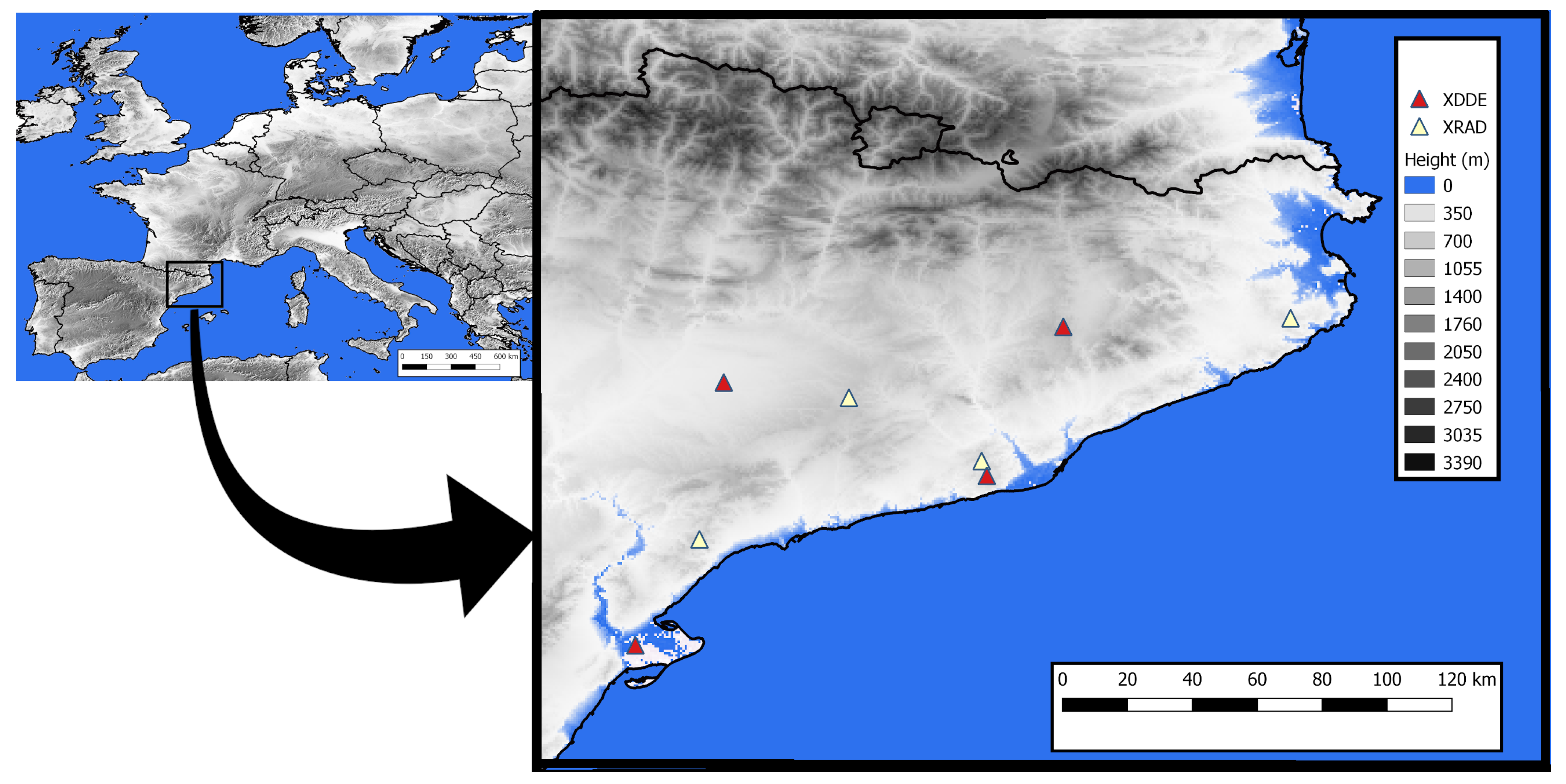
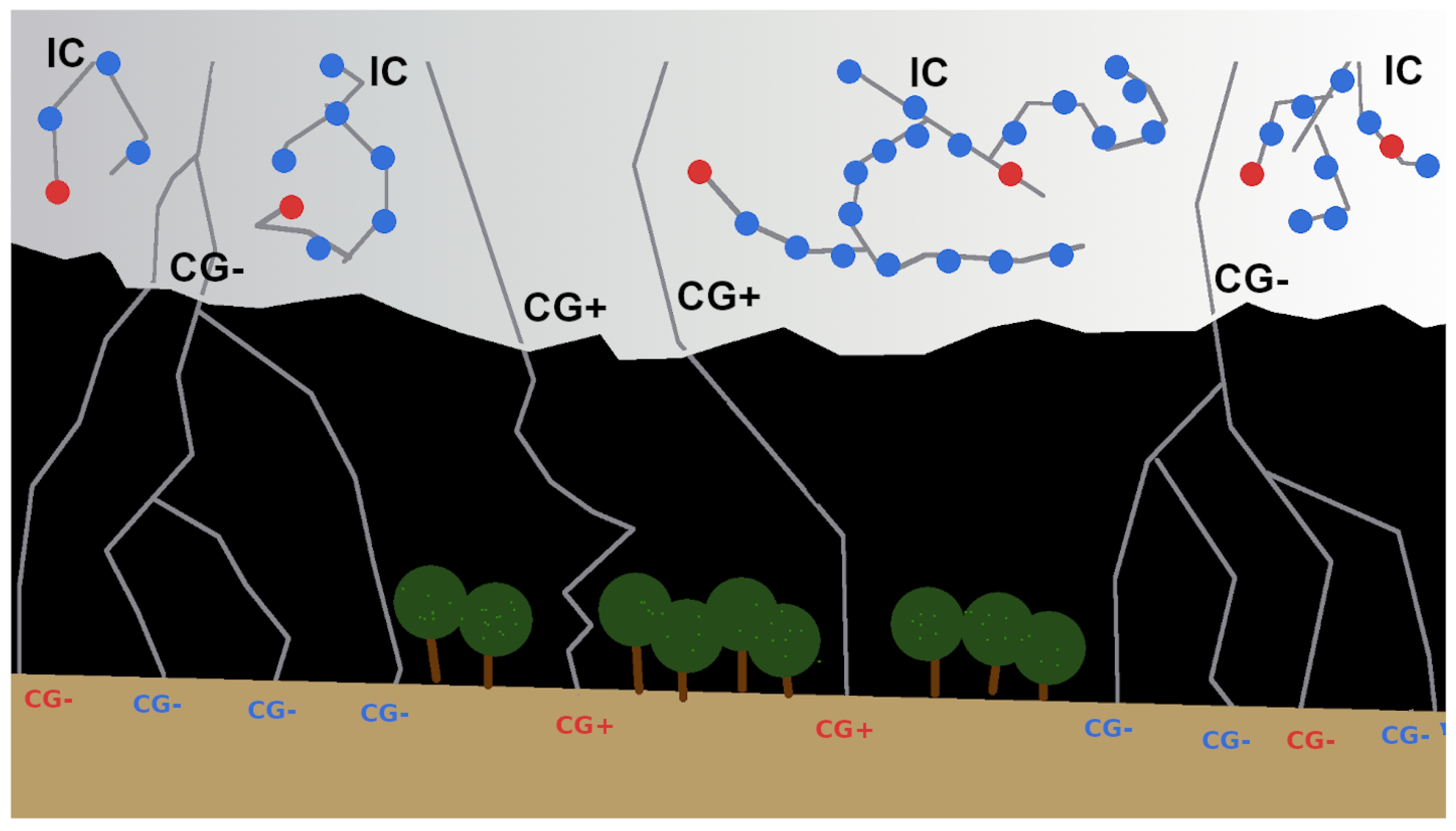

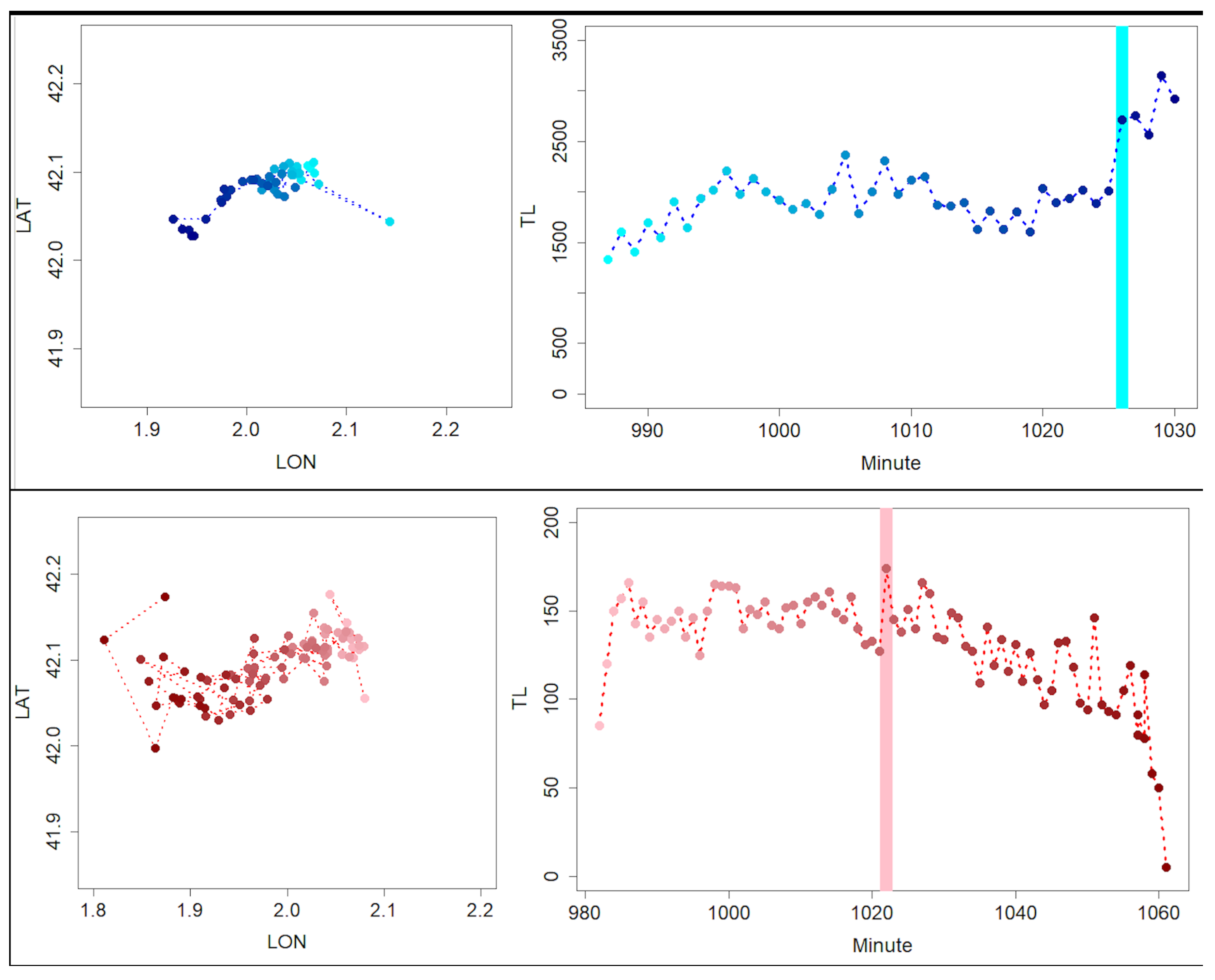
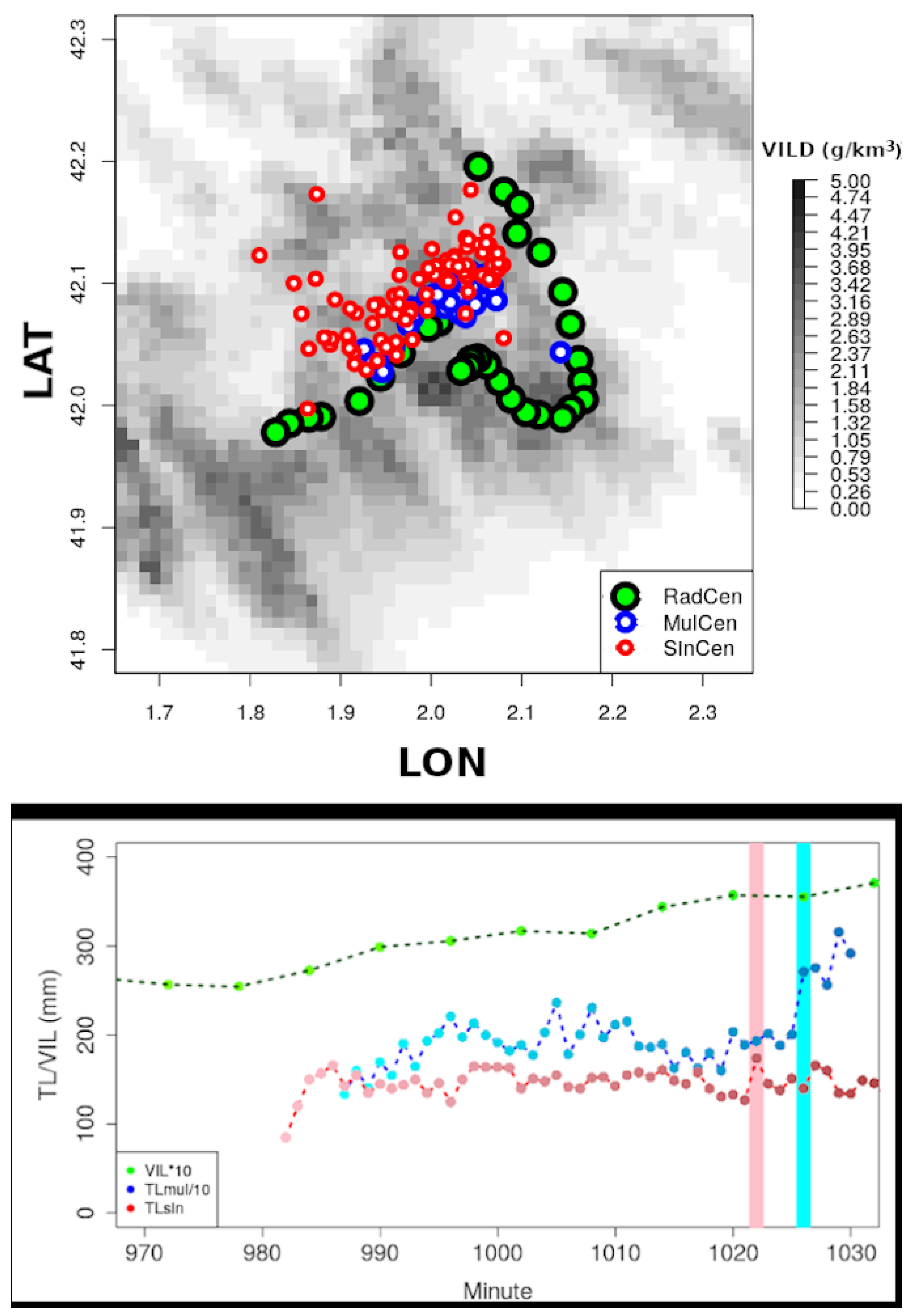
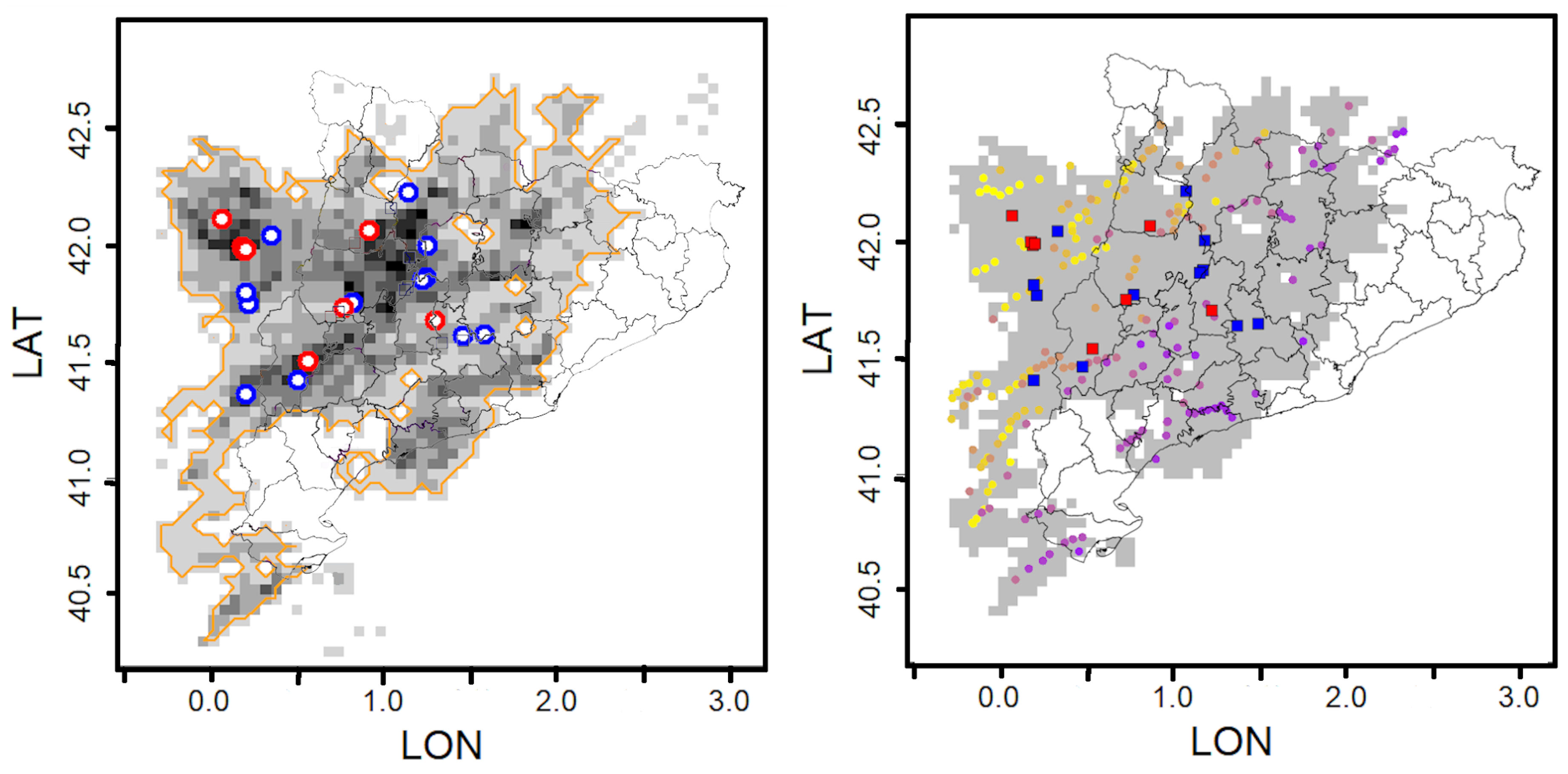
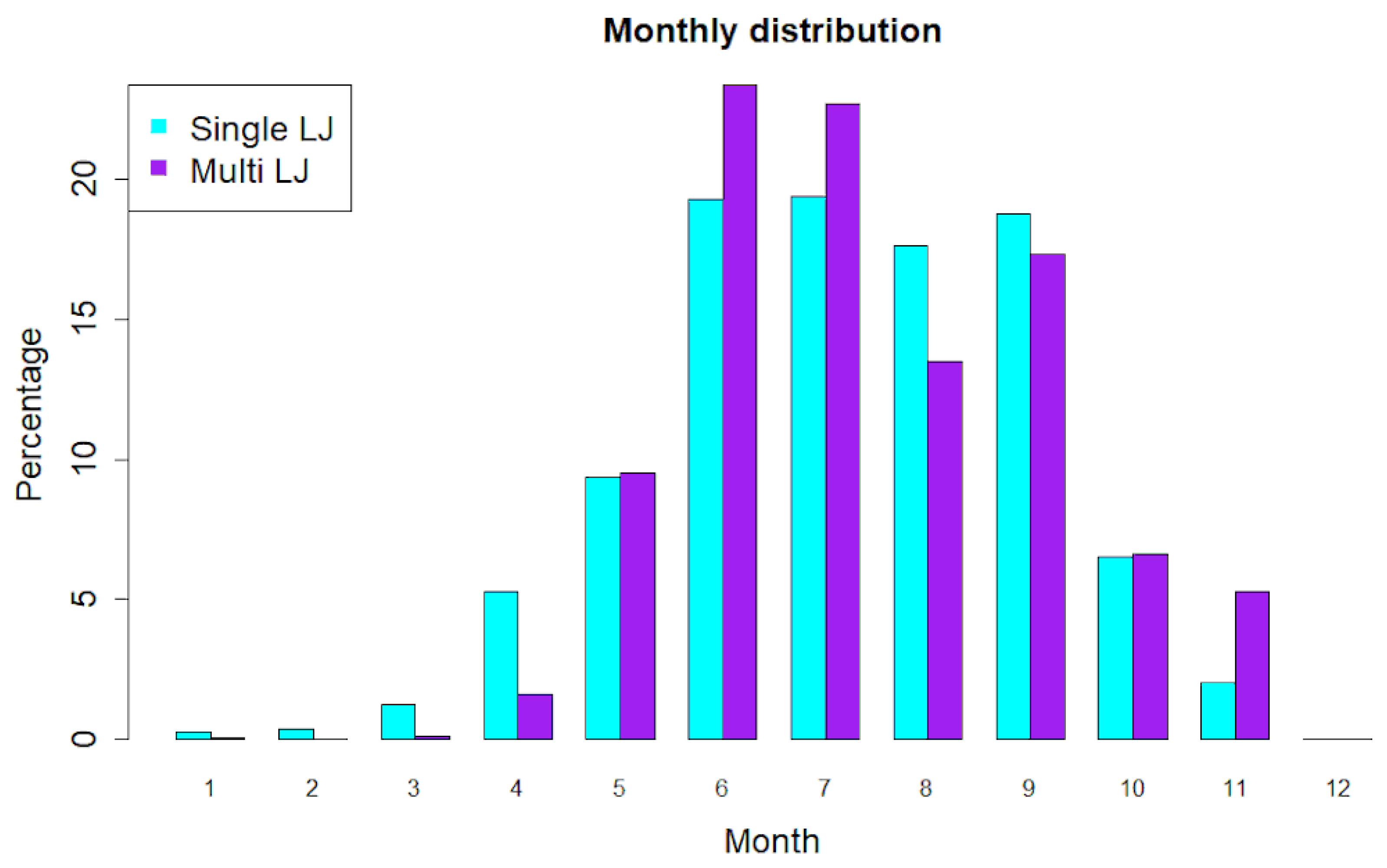

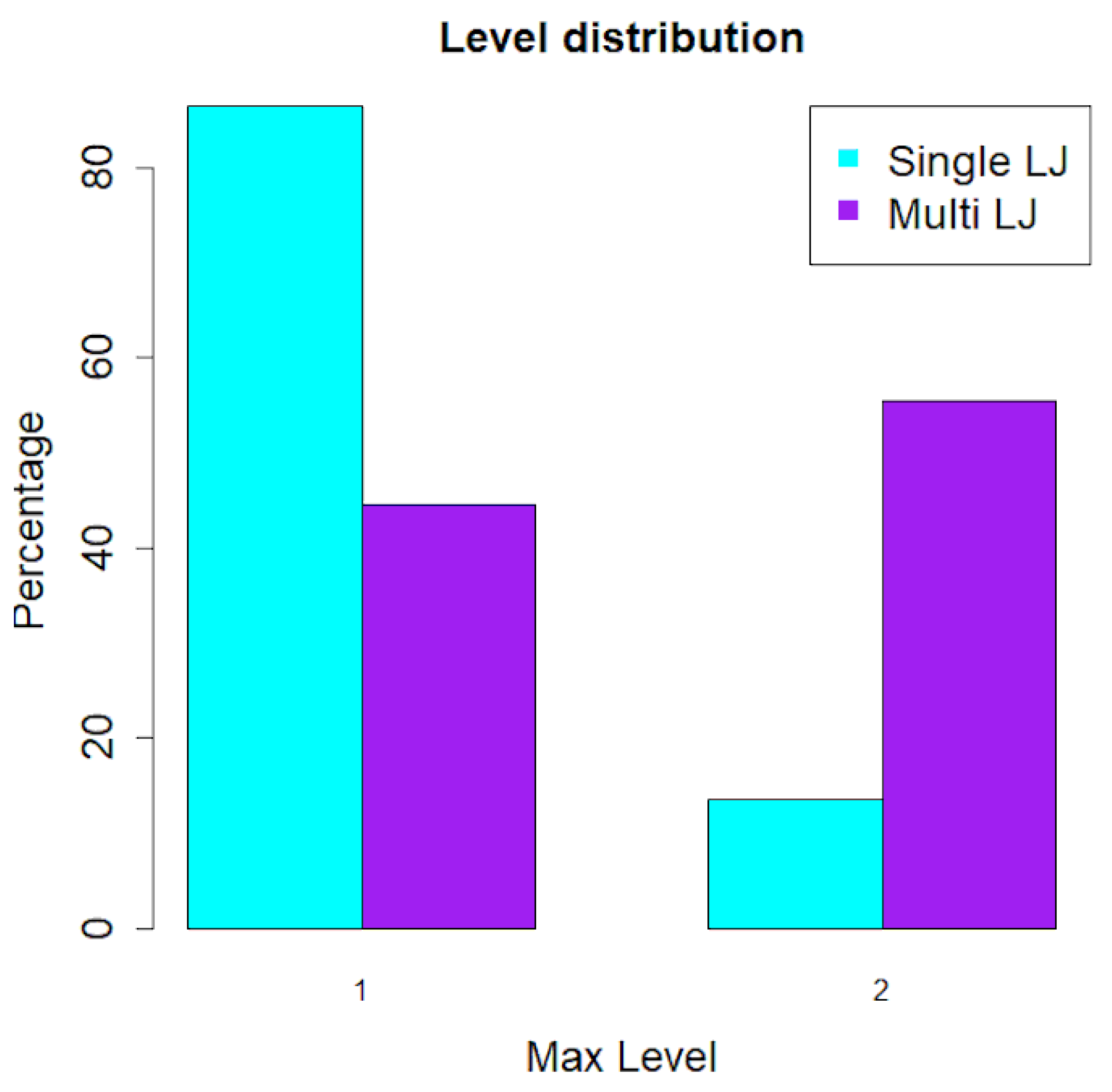
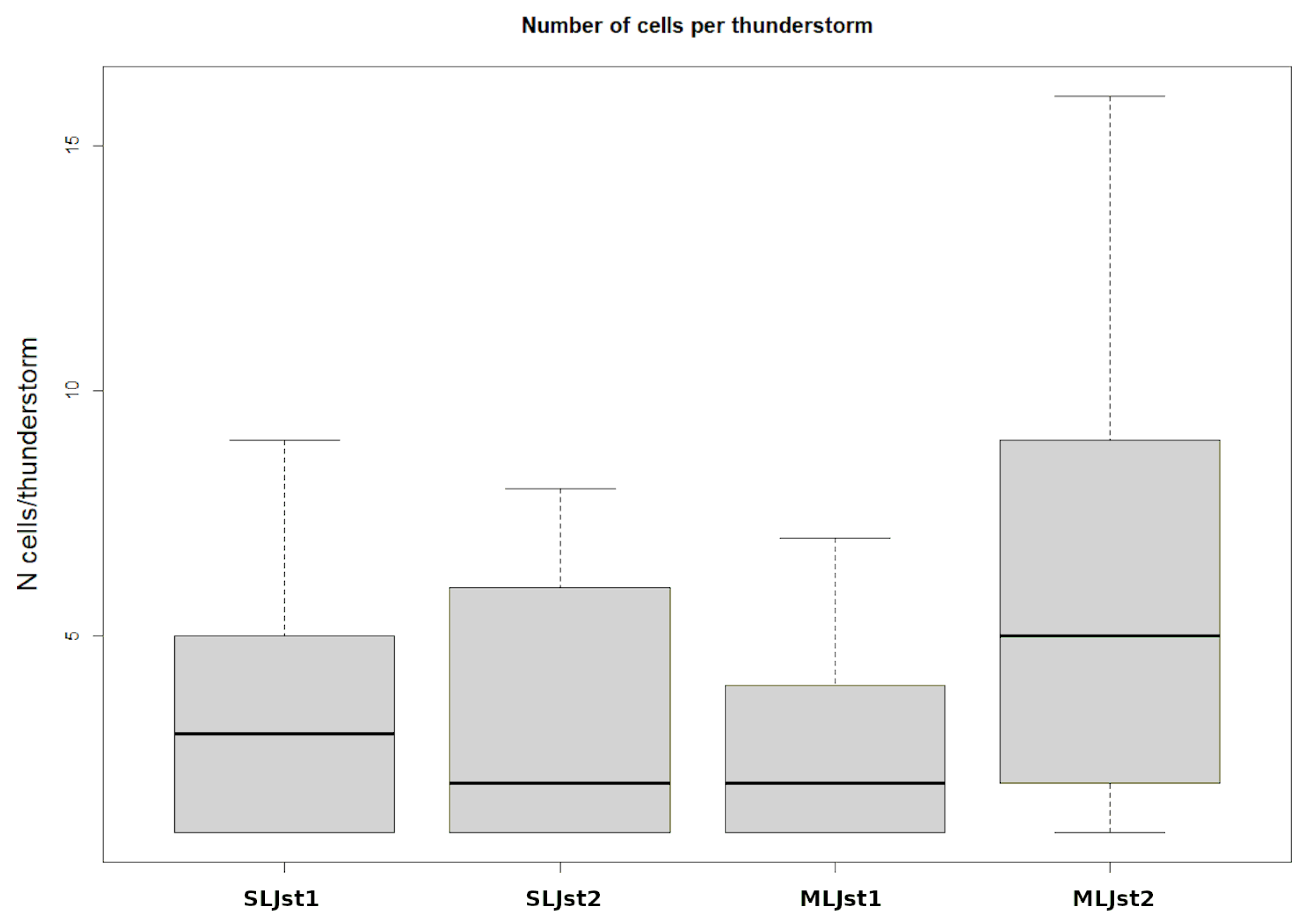

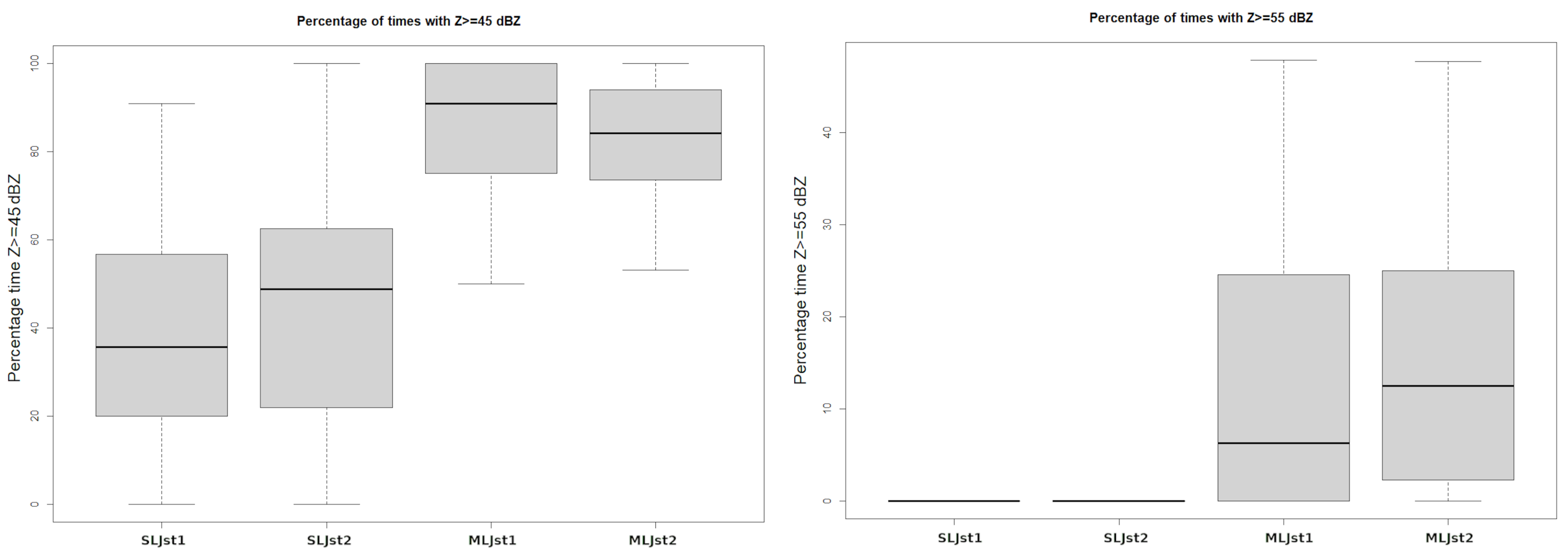
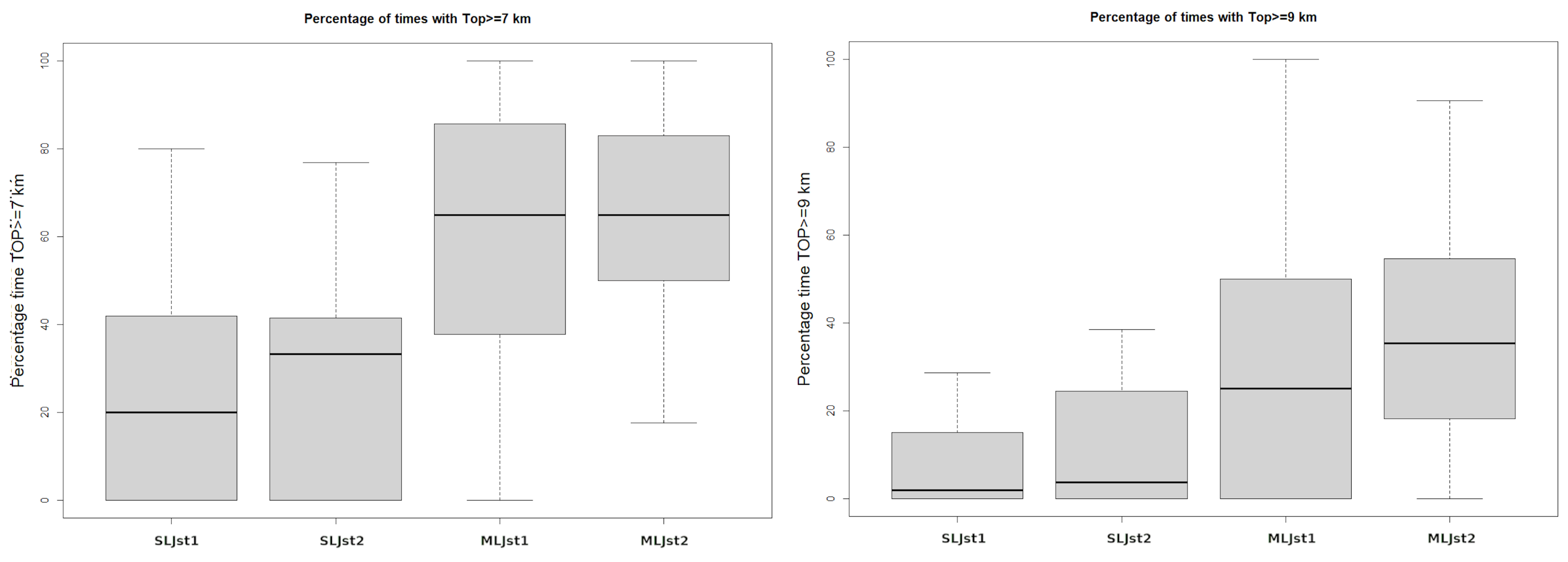

| Number LJ | 1 (800) | 2–4 (1013) | 5–9 (416) | 10–14 (130) | >14 (48) | |||||
|---|---|---|---|---|---|---|---|---|---|---|
| LJ Level | 1 | 2 | 1 | 2 | 1 | 2 | 1 | 2 | 1 | 2 |
| N cases | 691 | 109 | 967 | 384 | 416 | 338 | 130 | 122 | 48 | 47 |
| % | 86.4 | 13.6 | 95.4 | 37.9 | 100 | 81.3 | 100 | 93.8 | 100 | 97.9 |
| Isolated | Lineal | Unorganised | Organised | |
|---|---|---|---|---|
| SLJst1 | 104 | 50 | 186 | 241 |
| SLJst2 | 9 | 10 | 25 | 50 |
| MLJst1 | 64 | 88 | 34 | 36 |
| MLJst2 | 41 | 107 | 106 | 129 |
Publisher’s Note: MDPI stays neutral with regard to jurisdictional claims in published maps and institutional affiliations. |
© 2022 by the authors. Licensee MDPI, Basel, Switzerland. This article is an open access article distributed under the terms and conditions of the Creative Commons Attribution (CC BY) license (https://creativecommons.org/licenses/by/4.0/).
Share and Cite
Rigo, T.; Farnell, C. Characterisation of Thunderstorms with Multiple Lightning Jumps. Atmosphere 2022, 13, 171. https://doi.org/10.3390/atmos13020171
Rigo T, Farnell C. Characterisation of Thunderstorms with Multiple Lightning Jumps. Atmosphere. 2022; 13(2):171. https://doi.org/10.3390/atmos13020171
Chicago/Turabian StyleRigo, Tomeu, and Carme Farnell. 2022. "Characterisation of Thunderstorms with Multiple Lightning Jumps" Atmosphere 13, no. 2: 171. https://doi.org/10.3390/atmos13020171
APA StyleRigo, T., & Farnell, C. (2022). Characterisation of Thunderstorms with Multiple Lightning Jumps. Atmosphere, 13(2), 171. https://doi.org/10.3390/atmos13020171







